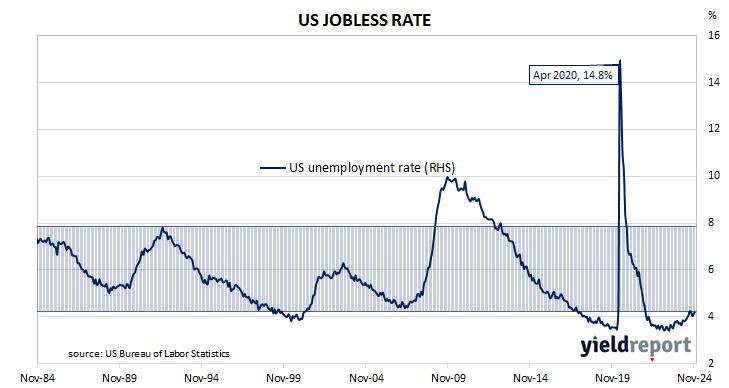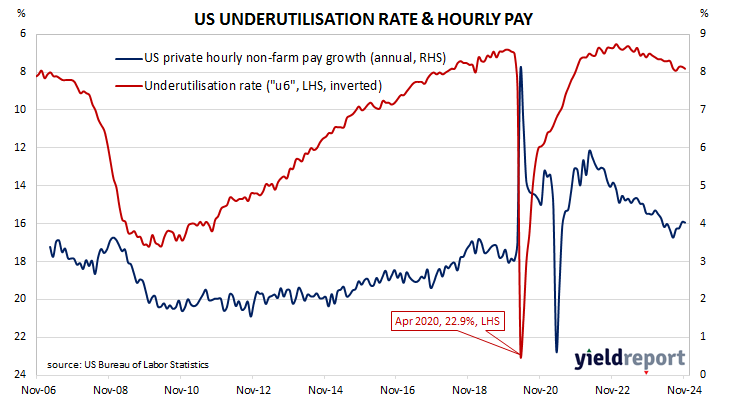Summary: US non-farm payrolls up 227,000 in November, above expectations; previous two months’ figures revised up by 56,000; jobless rate ticks up to 4.2%, participation rate slips to 62.5%; Westpac: US labour market conditions slowly softening; US Treasury yields fall; expectations of Fed rate cuts harden; employed-to-population ratio falls to 59.8%; underutilisation rate ticks up to 7.8%; annual hourly pay growth steady at 4.0%.
The US economy ceased producing jobs in net terms as infection controls began to be implemented in March 2020. The unemployment rate had been around 3.5% but that changed as job losses began to surge through March and April of 2020. The May 2020 non-farm employment report represented a turning point and subsequent months provided substantial employment gains which have continued to the present.
According to the US Bureau of Labor Statistics, the US economy created an additional 227,000 jobs in the non-farm sector in November. The increase was greater than the 200,000 rise which had been generally expected but well in excess of the 36,000 jobs which had been added in October after revisions. Employment figures for September and October were revised up by a total of 56,000.
The total number of unemployed increased by 161,000 to 7.145 million while the total number of people who were either employed or looking for work decreased by 194,000 to 168.286 million. These changes led to the US unemployment rate ticking up from 4.1% in October to 4.2%. The participation rate slipped from 62.6% to 62.5%.
“Labour market conditions are slowly softening with the unemployment rate ticking higher to 4.2% in November, while wage pressures remain contained,” said Westpac senior economist Pat Bustamante.
US Treasury bond yields fell by declining amounts across a steeper curve on the day. By the close of business, the 2-year yield had shed 5bps to 4.10%, the 10-year yield had lost 2bps to 4.16% while the 30-year yield finished unchanged at 4.34%.
In terms of US Fed policy, expectations of a lower federal funds rate in the next 12 months hardened, with at least another three 25bp cuts currently priced in. At the close of business, contracts implied the effective federal funds rate would average 4.49% in December, 4.36% in January and 4.285% in February. November 2025 contracts implied 3.715%, 87bps less than the current rate.
One figure which is indicative of the “spare capacity” of the US employment market is the employment-to-population ratio. This ratio is simply the number of people in work divided by the total US population. It hit a cyclical-low of 58.2 in October 2010 before slowly recovering to just above 61% in early 2020. November’s reading fell 0.2 percentage points to 59.8%, some way from the April 2000 peak reading of 64.7%.
Apart from the unemployment rate, another measure of tightness in the labour market is the underutilisation rate. The underutilisation rate ticked up from 7.7% to 7.8% in November. Wage inflation and the underutilisation rate have an inverse relationship over time but not necessarily from month to month. Private hourly pay growth in the year to November remained steady at 4.0%.



